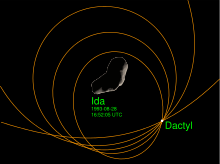(243) Ida I Dactyl (/ˈdæktɪl/ DAK-til) is a tiny asteroid moon (1 mile, or 1.6 km, in diameter) that orbits asteroid 243 Ida.[1] It was imaged by the Galileo spacecraft on August 28, 1993; Dactyl was discovered while examining the delayed image downloads from Galileo on February 17, 1994. It was provisionally designated S/1993 (243) 1.[2] The satellite was named after the mythical creatures called dactyls, who, according to Greek mythology, lived on Mount Ida.[3]
Orbit

Dactyl's orbit around Ida is not precisely known. Galileo was in the plane of Dactyl's orbit when most of the images were taken, which made determining its exact orbit difficult.[4] Dactyl orbits in the prograde direction[5] and is inclined about 8° to Ida's equator.[6] Based on computer simulations, Dactyl's pericenter must be more than about 65 km (40 mi) from Ida for it to remain in a stable orbit.[7] The range of orbits generated by the simulations was narrowed down by the necessity of having the orbits pass through points at which Galileo observed Dactyl to be at 16:52:05 UT on 28 August 1993, about 90 km (56 mi) from Ida at longitude 85°.[8][9] On 26 April 1994, the Hubble Space Telescope observed Ida for eight hours and was unable to spot Dactyl. It would have been able to observe it if it were more than about 700 km (430 mi) from Ida.[4]
If in a circular orbit at the distance at which it was seen, Dactyl's orbital period would be about 20 hours.[10] Its orbital speed is roughly 10 m/s (33 ft/s), "about the speed of a fast run or a slowly thrown baseball".[4]
Origin
The origins of Dactyl are unclear, but two main hypotheses exist. The first is that Dactyl and Ida formed at the same time, and the second is that Dactyl was knocked loose by a later impact.[11][12]
Dactyl was the first asteroid moon discovered. Its discovery settled the long debate over the existence of asteroid moons.
See also
External links
- 243 Ida and Dactyl from The Nine Planets
- Asteroid Ida and Dactyl from Views of the Solar System
- IAUC 5948 announcing Dactyl's discovery
- IAUC 6082 announcing Dactyl's naming
- Ida and Dactyl in false coloring, to reveal surface differences
References
- ^ "Asteroid 243 Ida and its newly discovered moon, Dactyl". www.esa.int. Retrieved 2022-08-11.
- ^ Clarke, Aubrey (August 28, 2021). "NASA Galileo Spacecraft Continues to Fulfill Many Tasks After Passing by Asteroid Ida 28 Years Ago". The Space Times.
- ^ "In Depth | 243 Ida". NASA Solar System Exploration. Retrieved 2022-08-11.
- ^ a b c Byrnes & D'Amario 1994
- ^ Petit et al. 1997, p. 179
- ^ Petit et al. 1997, p. 177
- ^ Petit et al. 1997, p. 195
- ^ Petit et al. 1997, p. 188
- ^ Petit et al. 1997, p. 193
- ^ Chapman et al. 1994, p. 455
- ^ Granahan, James (2002). "A compositional study of asteroid 243 Ida and Dactyl from Galileo NIMS and SSI observations". Journal of Geophysical Research. 107 (E10): 5090. Bibcode:2002JGRE..107.5090G. doi:10.1029/2001JE001759. ISSN 0148-0227.
- ^ Davis, Donald R.; Chapman, Clark R.; Durda, Daniel D.; Farinella, Paolo; Marzari, Francesco (1996). "The Formation and Collisional/Dynamical Evolution of the Ida/Dactyl System as Part of the Koronis Family". Icarus. 120 (1): 220–230. Bibcode:1996Icar..120..220D. doi:10.1006/icar.1996.0047.
Works cited
- Byrnes, Dennis V.; D'Amario, Louis A.; Galileo Navigation Team (December 1994). "Solving for Dactyl's Orbit and Ida's Density". The Galileo Messenger (35). Archived from the original on 1997-01-05. Retrieved 2008-10-23.
- Chapman, Clark R.; Klaasen, K.; Belton, Michael J. S.; Veverka, Joseph (July 1994). "Asteroid 243 IDA and its satellite". Meteoritics. 29: 455. Bibcode:1994Metic..29..455C.
- Petit, Jean-Marc; Durda, Daniel D.; Greenberg, Richard; Hurford, Terry A.; Geissler, Paul E. (November 1997). "The Long-Term Dynamics of Dactyl's Orbit". Icarus. 130 (1): 177–197. Bibcode:1997Icar..130..177P. CiteSeerX 10.1.1.693.8814. doi:10.1006/icar.1997.5788.



